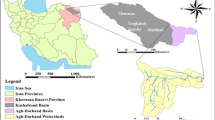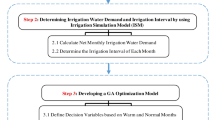Abstract
Demands for water, food, and energy are rising owing to increasing population and growing economy. Agriculture is the main source of food and is the largest consumer of water and has therefore the greatest impact on water security. It also greatly affects energy security and is also the main source of non-point source pollution. Changes in the availability of water, energy, and land are driven by uncertainties in nature and strongly affect food production, with severe implications for the security of water–food–energy nexus (WFEN). Thus, a coordinated and effective management of WFEN in the agricultural sector is needed. This paper therefore proposes an integrated modelling approach for the optimization of agricultural WFEN in a random environment. The approach quantifies the interactions and feedbacks within agricultural water, food and energy subsystems, making tradeoffs between agricultural benefit and environmental impacts, which will serve as sustainability indicators for agricultural systems, including crop farming and livestock farming. The incorporation of stochastic mathematical programming in the modeling framework aids in understanding how strategies and comprehensive benefits change under different scenarios. The approach was applied in a real-world case study in an irrigation district in northeast China. The development and implementation of such an integrated approach are anticipated to be applied in other agriculture-centered regions to guide policies of sustainable water, food, energy and land resources management.







Similar content being viewed by others
Abbreviations
- WFEN:
-
Water–food–energy nexus
- CCP:
-
Chance-constrained programming
- max:
-
Maximize
- min:
-
Minimize
- F:
-
Objective function
- SNB:
-
System net benefit
- SP:
-
System pollution
- inf:
-
Inferior value
- sup:
-
Superior value
- JXID:
-
Jinxi irrigation district
References
Bazilian M, Rogner H, Howells M, Hermann S, Arent D, Gielen D, Steduto P, Mueller A, Komor P, Tol RSJ, Yumkella KK (2011) Considering the energy, water and food nexus: towards an integrated modelling approach. Energy Policy 39:7896–7906
Berardy A, Chester MV (2017) Climate change vulnerability in the food, energy, and water nexus: concerns for agricultural production in Arizona and its urban export supply. Environ Res Lett 12:035004
Bieber N, Ker JH, Wang X, Triantafyllidis C, van Dam KH, Koppelaar RHEM, Shah N (2018) Sustainable planning of the energy–water–food nexus using decision making tools. Energy Policy 113:584–607
Cai XM, Wallington K, Shafiee-Jood M, Marston L (2018) Understanding and managing the food–energy–water nexus—opportunities for water resources research. Adv Water Resour 11:259–273
De Vito R, Portoghese I, Pagano A, Fratino U, Vurro M (2017) An index-based approach for the sustainable assessment of irrigation practice based on the water–energy–food nexus framework. Adv Water Resour 110:423–436
Guo P, Huang GH (2009) Two-stage fuzzy chance-constrained programming: application to water resources management under dual uncertainties. Stoch Environ Res Risk Assess 23:349–359
Howells M, Hermann S, Welsch M et al (2013) Integrated analysis of climate change, land-use, energy and water strategies. Nat Clim Change 3(7):621–626
Hussien WA, Memon FA, Savic DA (2017) An integrated model to evaluate water–energy–food nexus at a household scale. Environ Model Softw 93:366–380
Irwin E, Campbell J, Wilson R, Faggian A, Moore R, Irwin N (2016) Human adaptations in food, energy, and water systems. J Environ Stud Sci 6(1):127–139
Kaddoura S, Khatib SE (2017) Review of water–energy–food nexus tools to improve the Nexus modelling approach for integrated policy making. Environ Sci Policy 77:114–121
Karabulut AA, Crenna E, Sala S, Udias A (2018) A proposal for integration of the ecosystem–water–food–land–energy nexus concept into life cycle assessment: a synthesis matrix system for food security. J Clean Prod 172(20):3874–3889
Karnib A (2017) Water–energy–food nexus: a coupled simulation and optimization framework. J Geosci Environ Prot 5:84–98
Li M, Guo P (2014) A multi-objective optimal allocation model for irrigation water resources under multiple uncertainties. Appl Math Model 38:4897–4911
Li M, Fu Q, Singh VP, Liu D (2018) An interval multi-objective programming model for irrigation water allocation under uncertainty. Agric Water Manag 196:24–36
Li M, Fu Q, Singh VP, Ji Y, Liu D, Zhang CL, Li TX (2019) An optimal modelling approach for managing agricultural water–energy–food nexus under uncertainty. Sci Total Environ 651:1416–1434
Ren CF, Li ZH, Zhang HB (2019) Integrated multi-objective stochastic fuzzy programming and AHP method for agricultural water and land optimization allocation under multiple uncertainties. J Clean Prod 210:12–24
Singh VP, Khedun CP, Mishra AK (2014) Water, environment, energy, and population growth: implications for water sustainability under climate change. J Hydrol Eng 19(4):667–673
Sun W, Huang GH, Lv Y, Li G (2013) Inexact joint-probabilistic chance-constrained programming with left-hand-side randomness: an application to solid waste management. Eur J Oper Res 228(1):217–225
Tian H, Lu C, Pan S, Yang J, Miao R, Ren W, Yu Q, Fu B, Jin F, Lu Y, Melillo J, Ouyang Z, Palm C, Reilly J (2018) Optimizing resource use efficiencies in the food-energy-water nexus for sustainable agriculture: from conceptual model to decision support system. Curr Opin Environ Sustain 33:104–113
Wang YY, Huang GH, Wang S, Li W, Guan PB (2016) A risk-based interactive multi-stage stochastic programming approach for water resources planning under dual uncertainties. Adv Water Resour 94:217–230
White DJ, Hubacek K, Feng K, Sun LX, Meng B (2018) The water–energy–food nexus in East Asia: a tele-connected value chain analysis using inter-regional input–output analysis. Appl Energy 210:550–567
Xu Y, Li W, Ding X (2017) A stochastic multi-objective chance-constrained programming model for water supply management in Xiaoqing River Watershed. Water 9(6):378
Zhang XD, Vesselinov VV (2017) Integrated modeling approach for optimal management of water, energy and food security nexus. Adv Water Resour 101:1–10
Zhang C, Bernard AE, Guo P, Liu X, Guo SS, Zhang F, Wang YZ (2018) Double-sided stochastic chance-constrained linear fractional programming model for managing irrigation water under uncertainty. J Hydrol 564:467–475
Acknowledgements
This research was supported by the China Postdoctoral Science Foundation (2018T110264), National Natural Science Foundation of China (51809040, 51709195), and Natural Science Foundation of Heilongjiang Province of China (E2018004 and E2016005).
Author information
Authors and Affiliations
Corresponding author
Additional information
Publisher's Note
Springer Nature remains neutral with regard to jurisdictional claims in published maps and institutional affiliations.
Rights and permissions
About this article
Cite this article
Li, M., Singh, V.P., Fu, Q. et al. Optimization of agricultural water–food–energy nexus in a random environment: an integrated modelling approach. Stoch Environ Res Risk Assess 35, 3–19 (2021). https://doi.org/10.1007/s00477-019-01672-4
Published:
Issue Date:
DOI: https://doi.org/10.1007/s00477-019-01672-4




